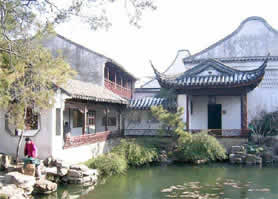The Master-of-the-Nets Garden, or Wang Shi Yuan, was first laid out during the Sung Dynasty (960- 1279) but was later abandoned. It was "rediscovered" in the 18th century by a retired official who restored the gardens. Like many Confucian scholar-officials, he preferred the peace of nature to the wrangling of Court life. He is said to have remarked that he would rather be a fisherman than a bureaucrat. This is the origin of the garden's name. 1279) but was later abandoned. It was "rediscovered" in the 18th century by a retired official who restored the gardens. Like many Confucian scholar-officials, he preferred the peace of nature to the wrangling of Court life. He is said to have remarked that he would rather be a fisherman than a bureaucrat. This is the origin of the garden's name.
Like the Humble Administrator's Garden, this garden is divided into three parts: an eastern section, or residential area; a central section, or main garden; and a western section, or the inner garden. This garden is, however, one of the smallest in Suzhou. It is only 1/10 of the size of the Humble Administrator's Garden.
The residential section of the garden is built with strict regard to the sumptuary regulations of the times. The front door is particularly notable for its ornamentation indicating the owner's courtly rank. Inside are numerous halls, each of which is connected separately to the central garden. All of the halls are placed on the standard north-south axis as is common in China.
The main garden has a large central pond (440 square meters) surrounded by a number of verandas and walkways. In the pond is a small hexagonal pavilion of the type commonly found in other Suzhou gardens. Also in the pond is a smalls stone bridge called Yinjing Bridge (Leading to Serenity Bridge). Its width is less than one foot.
The inner garden contains the beautiful Dianchun Studio which was replicated at the Metropolitan Museum of New York and the Pompidou Center in Paris. |
